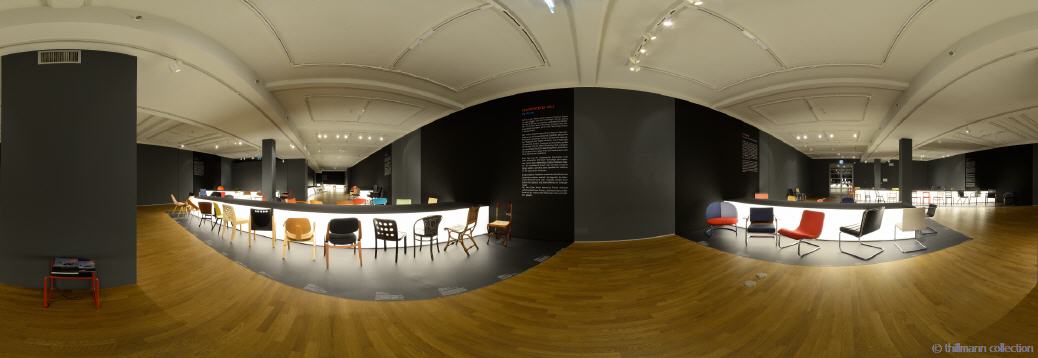Exhibition Leipzig

„SITZEN - LIEGEN - SCHAUKELN. Möbel von Thonet“
(SIT - LIE - ROCK. Furniture from Thonet)
GRASSI Museum for Applied Arts , Leipzig
From 17.04.2014 to 14.09.2014
The Exhibition
This exhibition in the GRASSI Museum presented for the first time not only the classical Thonet furniture, but focused on the new developments in Thonet Frankenberg since 1945. Even for experts this exhibition provided surprises. Hardly no one knew the different designs of the 1950s and 1960s, and only a few know that designers like Norman Foster, Verner Panton or Konstantin Grcic have made chair designs for the Thonet company in Frankenberg. The 130 pieces of seating furniture were evidence of a successful synthesis of tradition and contemporary design.
The spectrum ranged from the simple kitchen chair, office chairs, leisure chairs, lounge and rocking chairs to medical beds, seating furniture for the garden and children's furniture .
On some of the currently produced Thonet models visitors could sit down.
Company founder Michael Thonet (1796 - 1871) received in 1856 the patent for the bending of solid wood. Thonet had been searching for techniques to produce beautiful, durable and affordable furniture in large series. With chair "No.14", first presented in 1859, he demonstrated this in an outstanding way. Many followers of the model compete until today with the successful unit of good design and economic production. In the 1930 the potential of the new material tubular steel was recognized at Thonet. Soon after, Thonet was the world's largest producer of tubular steel furniture.
Even after 1945 bentwood and tubular steel are identification marks of many Thonet models, although the technology has been adapted to today's requirements or combined with alternative production techniques. With the renaissance of bentwood furniture in the 1960s, the coffee house chair No.14 attained almost cult status. Even the youngest generation of designers with modern interpretations refers to the unchanged timeliness of this classic chair. Stefan Diez, designer for Thonet is thrilled by " this crazy idea to bend wood like this, so as if it grows a second time".
The chair designs from 1945 to the present must always be seen against the background of the company’s long tradition. Typical construction methods and technologies and aesthetic principles are recognizable across generations as a common thread. The company's own design department, but also famous external designers such as Verner Panton, Gerd Lange, Robert Stadler, Stefan Diez, Norman Foster, Peter Maly and Konstantin Grcic provided and provide designs for Thonet, testifying the respectful treatment of the classics while maintaining strictly their autonomy.
Yesterday and today Thonet furniture stands for good and thoughtful design and good quality of materials and workmanship.
The Presentation
The presentation was not chronological, but organized according to types of furniture, materials and themes. Sabine Epple, the curator, consciously had chosen this not chronological approach. In the first part of the exhibition all members of the "Thonet family" were gathered around tables: dramatically lit islands, aesthetically appealing and very well done.
Bentwood from the second half of the 19th century stood next to designs from the 21st century; Art Nouveau armchairs could be found next to seating furniture, which showed stylistic principles of functionalism. Folding and stackable chairs beside office furniture from different periods, tubular steel on four legs and cantilever chairs, swivel chairs and office furniture. Plywood could be found next to furniture made of plastic - both materials that can be molded. And so all the members of the Thonet family came together, their history was alive.
The second room overlooking the courtyard Grassi was designed more conventional. On sloping brightly orange platforms thematically organized groups of furniture could be found here, too. Club chairs next to children's furniture, beds and outdoor furniture and rocking chairs. It was a contrast to the dramatic lighting of the first room, the sunlight illuminated the objects gently.
Click here for a virtual tour.
As an " introduction " to the exhibition we found in the vestibule two display cases in which miniature models of some of the exhibited furniture from the Dowald Collection could be seen.
With the exhibition a catalogue "Sitzen - Liegen - Schaukeln. Möbel von Thonet" was published in which the curator of the exhibition, Sabine Epple, in an interesting essay: "Progress in the constants" extensively describes the history of Thonet Frankenberg after 1945 in their respective historical context. The most extensive part of the catalogue shows the important and essential designs of Thonet Frankenberg from 1950 to today. The essay: "Thonet. Experiment and Innovation 1830 - 1939 " by Wolfgang Thillmann gives a comprehensive overview of the history of the company from its beginnings in Boppard up to the 2nd World War. The main focus lays on the early years in Vienna, where a number of innovative technical experiments provides the basis for the later success. A variety of pictures and graphics illustrates this path.

